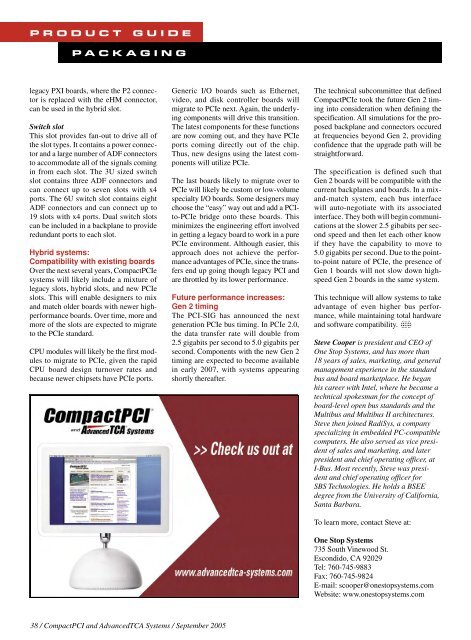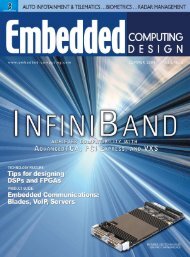CompactPCI and AdvancedTCA Systems - OpenSystems Media
CompactPCI and AdvancedTCA Systems - OpenSystems Media
CompactPCI and AdvancedTCA Systems - OpenSystems Media
You also want an ePaper? Increase the reach of your titles
YUMPU automatically turns print PDFs into web optimized ePapers that Google loves.
P R O D U C T G U I D E<br />
P A C K A G I N G<br />
legacy PXI boards, where the P2 connector<br />
is replaced with the eHM connector,<br />
can be used in the hybrid slot.<br />
Switch slot<br />
This slot provides fan-out to drive all of<br />
the slot types. It contains a power connector<br />
<strong>and</strong> a large number of ADF connectors<br />
to accommodate all of the signals coming<br />
in from each slot. The 3U sized switch<br />
slot contains three ADF connectors <strong>and</strong><br />
can connect up to seven slots with x4<br />
ports. The 6U switch slot contains eight<br />
ADF connectors <strong>and</strong> can connect up to<br />
19 slots with x4 ports. Dual switch slots<br />
can be included in a backplane to provide<br />
redundant ports to each slot.<br />
Hybrid systems:<br />
Compatibility with existing boards<br />
Over the next several years, <strong>CompactPCI</strong>e<br />
systems will likely include a mixture of<br />
legacy slots, hybrid slots, <strong>and</strong> new PCIe<br />
slots. This will enable designers to mix<br />
<strong>and</strong> match older boards with newer highperformance<br />
boards. Over time, more <strong>and</strong><br />
more of the slots are expected to migrate<br />
to the PCIe st<strong>and</strong>ard.<br />
CPU modules will likely be the first modules<br />
to migrate to PCIe, given the rapid<br />
CPU board design turnover rates <strong>and</strong><br />
because newer chipsets have PCIe ports.<br />
Generic I/O boards such as Ethernet,<br />
video, <strong>and</strong> disk controller boards will<br />
migrate to PCIe next. Again, the underlying<br />
components will drive this transition.<br />
The latest components for these functions<br />
are now coming out, <strong>and</strong> they have PCIe<br />
ports coming directly out of the chip.<br />
Thus, new designs using the latest components<br />
will utilize PCIe.<br />
The last boards likely to migrate over to<br />
PCIe will likely be custom or low-volume<br />
specialty I/O boards. Some designers may<br />
choose the “easy” way out <strong>and</strong> add a PCIto-PCIe<br />
bridge onto these boards. This<br />
minimizes the engineering effort involved<br />
in getting a legacy board to work in a pure<br />
PCIe environment. Although easier, this<br />
approach does not achieve the performance<br />
advantages of PCIe, since the transfers<br />
end up going though legacy PCI <strong>and</strong><br />
are throttled by its lower performance.<br />
Future performance increases:<br />
Gen 2 timing<br />
The PCI-SIG has announced the next<br />
generation PCIe bus timing. In PCIe 2.0,<br />
the data transfer rate will double from<br />
2.5 gigabits per second to 5.0 gigabits per<br />
second. Components with the new Gen 2<br />
timing are expected to become available<br />
in early 2007, with systems appearing<br />
shortly thereafter.<br />
The technical subcommittee that defined<br />
<strong>CompactPCI</strong>e took the future Gen 2 timing<br />
into consideration when defining the<br />
specification. All simulations for the proposed<br />
backplane <strong>and</strong> connectors occured<br />
at frequencies beyond Gen 2, providing<br />
confidence that the upgrade path will be<br />
straightforward.<br />
The specification is defined such that<br />
Gen 2 boards will be compatible with the<br />
current backplanes <strong>and</strong> boards. In a mix<strong>and</strong>-match<br />
system, each bus interface<br />
will auto-negotiate with its associated<br />
interface. They both will begin communications<br />
at the slower 2.5 gibabits per second<br />
speed <strong>and</strong> then let each other know<br />
if they have the capability to move to<br />
5.0 gigabits per second. Due to the pointto-point<br />
nature of PCIe, the presence of<br />
Gen 1 boards will not slow down highspeed<br />
Gen 2 boards in the same system.<br />
This technique will allow systems to take<br />
advantage of even higher bus performance,<br />
while maintaining total hardware<br />
<strong>and</strong> software compatibility.<br />
Steve Cooper is president <strong>and</strong> CEO of<br />
One Stop <strong>Systems</strong>, <strong>and</strong> has more than<br />
18 years of sales, marketing, <strong>and</strong> general<br />
management experience in the st<strong>and</strong>ard<br />
bus <strong>and</strong> board marketplace. He began<br />
his career with Intel, where he became a<br />
technical spokesman for the concept of<br />
board-level open bus st<strong>and</strong>ards <strong>and</strong> the<br />
Multibus <strong>and</strong> Multibus II architectures.<br />
Steve then joined RadiSys, a company<br />
specializing in embedded PC-compatible<br />
computers. He also served as vice president<br />
of sales <strong>and</strong> marketing, <strong>and</strong> later<br />
president <strong>and</strong> chief operating officer, at<br />
I-Bus. Most recently, Steve was president<br />
<strong>and</strong> chief operating officer for<br />
SBS Technologies. He holds a BSEE<br />
degree from the University of California,<br />
Santa Barbara.<br />
To learn more, contact Steve at:<br />
One Stop <strong>Systems</strong><br />
735 South Vinewood St.<br />
Escondido, CA 92029<br />
Tel: 760-745-9883<br />
Fax: 760-745-9824<br />
E-mail: scooper@onestopsystems.com<br />
Website: www.onestopsystems.com<br />
38 / <strong>CompactPCI</strong> <strong>and</strong> <strong>AdvancedTCA</strong> <strong>Systems</strong> / September 2005

















